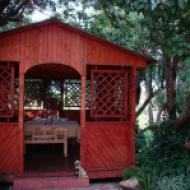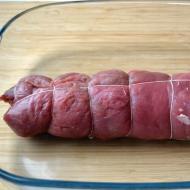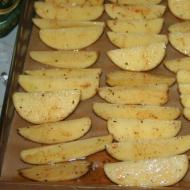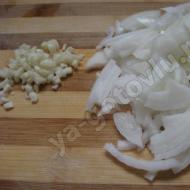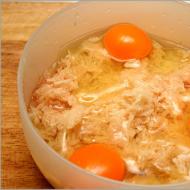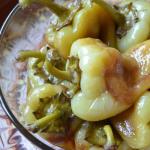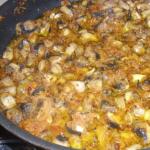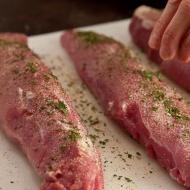
How to work on the beer column correctly. The concept, milestones of development and features of the operation of the beer column. The principle of operation of the film column
Quick navigation through the article
The "invention" of the beer column is based on the industrial production of alcohol. That is, the industrial installation was "reduced" to small sizes. But it turned out that not everything is so simple.
As in other settings, a simple proportional reduction does not bring the desired result: either the speed is low, or the quality is lame. But problem analysis and ingenuity make you move forward and achieve your goal. How it all happened:
- At first, someone thought of attaching a tsargu to the moonshine still. Initially, with its help, they tried to solve the problem of spraying. But then they found that because of this adaptation, the final product is partially deprived of a peculiar fusel smell and becomes somewhat stronger. The idea was picked up by amateur distillers and those who make moonshine stills on an industrial scale.
- But complete satisfaction with the result did not come. And the experiments continued. The tsarga was lengthened, turning it into a film (it is also strengthening) column. It became better and more productive, but shortcomings were revealed again.
- Then a water jacket was placed on the film in the upper part and a mash column appeared.
- And the invention of once-through and shell-and-tube refrigerators solved another problem: it increased the speed of the haul.
- Another type of beer is a continuous column. But it is arranged in a slightly different and more complicated way. More on this below.
What gives?
With the help of this particular add-on over the distillation cube, it is possible to obtain moonshine with a strength of 80-90 °. Almost alcohol, but not devoid of the aroma of the feedstock, as when using a distillation column. The purity of the distillate is controversial.
There are also allegations that supposedly someone once conducted studies that revealed monstrous excesses in fusel oils and other impurities. But not a single concrete fact (place, time, appearance, names) was presented to the public. What makes the very fact of such a study, and not just its results, questionable.
But experienced moonshiners already know: even at the rectifier, the head fractions are selected separately and the “tails” are separated. Therefore, with the correct double distillation on the beer column, the product will meet the quality requirements, remaining with the organoleptics inherent in the beer (taste, smell of raw materials: fruits, grains, etc.). And the fortress - almost corresponding to rectified alcohol.
Design
The mash column is a copper or stainless steel pipe installed vertically above the cube. Consists of segments:
- Hollow high pipe with a diameter of 23-50 cm. Its height is equal to thirty times the diameter. That is, for 23 cm, the height is 69 cm, for 50 mm - 1.5 meters.
Attention. On sale there are beer columns of a different ratio (as a rule, downward)
But practice has proven that they cope worse with their task. That inclines to the idea of self-production.
- On the pipe in the upper part, occupying approximately 25% of the length, but not reaching the very top, a primary cooler for running water is mounted. Its purpose is to cool the vapors coming out of the distillation cube when heated.
- A thermometer is mounted on top of the refrigerator in the column. It is better if it is electronic, since the temperature is needed exact, and not approximate, as in distillation. The Chinese bimetallic thermometer also performs this task, but it is better not to put it in the column.
Important. In the beer column, two electronic thermometers are required, calibrated, with the same readings
One is mounted in a distillation cube, the other is on a column.
- From the mash column there is an adapter tube made of the same metal as the pipe, but 8-10 mm thick, to a coil placed in a cooler with a water jacket.
- In a refrigerator with running water, the vapors finally condense, flowing into a receiving container with a strong distillate.
Destiny moonshine stills


This is already a Chinese manufacturer, the assortment of which is not as large as that of Distillarus, but with its own characteristics and slightly lower prices, even despite paid delivery (I believe that Distillarus’s delivery is already included in the price). Almost every product has positive reviews. In compiling our moonshine still, we will use some of the components from this store.
Price: from 8,653 rubles per column with delivery
20 liter stainless steel saucepan converted to an alembic. Lid handle cut off. The clamp pipe is welded in - according to our plans, it is replaced by a fitting on nuts with gaskets. Welded clips are replaced with stationery clips.
So, we figured out the ready-made solutions, there are not many of them, it's time to show imagination and assemble your own moonshine still, or rather a beer column, using only (well, almost only) pieces of iron from China. Let's start, perhaps, with the refinement of an ordinary stainless steel pan, which will become our alembic. Of course, if bills crunch in your pocket, then you can immediately order an alembic in a Russian store or from the same AliExpress (a 23-liter tank from the same Destiny will cost about 10,500 rubles). But suppose that it rings in our pockets, and does not crunch, so we will save money - we will buy an ordinary stainless steel pan (you can dream up here too, for example, take a beer keg instead of a pan and modernize it) of the volume we need and do everything so that it approached the role of a distillation cube. And first you need to make holes in it for fastening for the drawer side, for thermometer sleeves and, of course, for the drain tap. And for this we need drills.
Work in the mode of Wash Column BK
Description of the mode and principle of operation
Necessary equipment.
Assembly order.
- Place the gasket (2) on the cube (1), install the cover (3) and hand-tighten with the wing nuts (6). All lambs must be clamped!
Re-distillation (fractional) - BC mode.
Stabilization of the regime (work for yourself).
Head selection.
Body selection.
The skills to manage this operation will come after a few distillations.
Selection of "tails".
How it works
Let's consider the principle of operation of the beer column so that you can finally understand: do you want such equipment for yourself?
- Braga is supplied to the heat receiver (upper part of the column pipe) using a pump.
- While in the column, it begins to interact with water vapor heated to almost 100°C in countercurrent mode.
- Heat exchange occurs: alcohol evaporates, other components of the mash, which have a high boiling point, flow down and are removed.
- On jumpers made of mesh material, located horizontally, focal bubbling occurs. Because of this, the percentage of alcohol in the vapor increases. This is what causes the high resulting moonshine.
- Unnecessary components (fuel fumes) are removed from the mash in a column with liquid selection, at a temperature below 76°C. The temperature must be regulated using the speed at which the mash is supplied, as well as its temperature.
Hi all!
A couple of weeks ago, I came across a very interesting equipment for moonshiners - beer column. It is also called a film column or a fortified distiller. One of my acquaintances, a distiller, bought it and kindly offered to test this unit.
What is the outcome you ask? My colleague makes excellent 88-degree moonshine, and now I know what to answer readers when they ask me "How to make strong moonshine." Interested?
And so, in today's article I will tell you what a mash column is, the principle of its operation and how to properly drive moonshine on it.
What is a wash (film) column
Now I will briefly describe what the mash column is for, and in the next chapter I will analyze in more detail the principle of its operation.
So, a film column is equipment that allows you to get very strong and clean moonshine. Up to 90 degrees! And at the same time, the equipment is quite simple in design and use, and its price is relatively small. It is installed directly on the distillation cube.

In appearance, the mash column resembles an ordinary once-through distiller. In fact, the way it is, the only difference is that another refrigerator is installed on the pipe ascending from the cube. The so-called dephlegmator or partial condenser.
This is where the whole point lies. But more on that in the next chapter.
The principle of operation of the film column
To make it clearer, I drew a simple scheme of work.

So, as I said, the column is placed directly on the distillation cube. The heated vapors of moonshine from the cube enter the partial (in Russian - partial) condenser. There, part of the vapor condenses and settles on the walls of the cooler, while the other part goes further.
Therefore, the first cooler is called partial, because. it does not condense all the vapor.
The liquid that has settled on the walls of the cooler is called phlegm. Hence the other name of the partial cooler - dephlegmator.
As you remember, moonshine consists of various impurities, which are conditionally divided into three main groups - “heads”, “body” and “tails”. The heads evaporate at a lower temperature than the rest of the groups. The body is at a higher temperature than the heads, while the tails are the highest boiling fraction. We drink, as we know, only the body, and cut off everything else. This race is called fractional.
So, by cooling moonshine vapors in a dephlegmator, we separate them and let the lower-boiling components pass on, and everything else condenses on the walls of the cooler and flows back into the cube as a film.
Hence the second name of the column - film.
At the same time, the alcohol-containing vapor rising in the side of the partial condenser constantly interacts with the phlegm flowing towards it. There is a process of heat and mass transfer - steam snatches low-boiling components from phlegm and gives it high-boiling ones (fusel oils and water). Hence such a frenzied strengthening - up to 90 degrees of the final product!
By regulating the temperature in the dephlegmator with water, we can quite qualitatively divide moonshine into fractions and cut off unnecessary parts of it. To begin with, we set the temperature so that only the “heads” pass into the second cooler, and return the alcohol and everything else to the cube. And then we raise the temperature and drive out the alcohol, leaving the “tails” in the phlegm.
But in order to clearly cut off the heads with tails and get a clean and strong moonshine with a column, you need to work correctly. Luckily, this is pretty easy to learn.
How to work on the beer column
- First race.
Well, everything is simple. Our column will work only as a distiller, the dephlegmator is not used. We supply water only to the second refrigerator and distill the mash into raw alcohol as quickly as possible. For those who do not know why this is done - read the article double fractional distillation.
- Second race.
Goal selection
We start to heat the cube. When the temperature in the cube approaches 75 degrees, we supply water to both coolers. Moreover, so much water must be supplied to the reflux condenser so that the steam in it is completely condensed and does not enter the second cooler. Those. nothing should flow into the receiving container.
This mode of operation is called "working for yourself." It should last 25-30 minutes. During this time, the head factions will concentrate in the tsar.
Now, very carefully, we begin to reduce the water supply to the strengthening distiller until moonshine begins to drip from the second cooler at a speed of 2-3 drops per second. It is worth noting that the response time of the column to a change in the water supply is quite large.
Therefore, it is necessary to pause between changes in the incoming parameters - slightly reduce the water and wait 30 seconds. Then look at the result and, if necessary, subtract more. Or added.
And so, at a speed of 2-3 drops per second, we select the heads. They are usually selected for smell, but if your moonshine experience does not yet allow you to do this, then use the standard proportion - 50 ml per kilogram of sugar in Braga.
When the heads are over, we change the container and begin the selection of the body.
body selection
Slowly reduce the water supply to the dephlegmator. Moonshine starts to come out faster. The less water you supply, the faster the process starts. But at the same time, the strength and purity of the distillate falls.
Here choose for yourself - either faster to the detriment of the degree of purification and degrees, or stronger and cleaner, but longer.
A compromise solution, in my opinion, is the speed at which moonshine goes in a thin stream.
Now it's time to pay attention to the thermometer installed above the film column. At this point, a certain temperature should be fixed on it. I can’t say which one you will have, because. it depends on the strength of your raw alcohol poured into the apparatus.
But here's what you need to remember. If you have chosen the correct selection mode, then the temperature should be kept at this level. If it grows, even if very slowly (by 1-1.5 degrees), but constantly, then we are supplying too much heat and the moonshine is of inadequate quality. Therefore, either increase the water supply, or reduce the heating.
Now that we have adjusted the column and strong moonshine flows from the second straight-through, and the temperature of the alcohol-containing steam leaving the column is constant (ranges between 0.1-0.2 degrees), we select the body.
But after some time, the temperature still begins to increase - all because there is less alcohol in the cube. Then it is necessary to slightly increase the amount of water supplied to the dephlegmator again. The temperature will return to its previous value, but the amount of moonshine coming out will decrease.
In this mode, we select the body to the tails. For experienced moonshiners, their appearance will be prompted by their own nose. For beginners, I recommend proceeding to the selection of tails when the temperature in the cube (in the cube, and not above the column!) Rise to 93ºС.
Tailings selection
If you are collecting tailings, then simply turn off the water supply to the reflux condenser and squeeze out the residues as in normal distillation. Just in case, let me remind you that we collect the tails in a separate container.
Update: In February, I purchased my own film column HD/4-2500 PK produced by Moonshine and Vodka. It has been slightly modified compared to the factory design - the dephlegmator has been insulated and needle valves have been installed to regulate the water supply.
General impression and conclusions
I liked working on the film column. And the resulting product was also to the taste.
I will list perhaps the advantages that I noted
- The heads are concentrated, with a pungent odor. The line when they end and the body begins is well felt. It's the same with tails. Therefore, moonshine can be clearly divided into fractions and a very high-quality product can be obtained.
- The strength of the distillate reaches 80-90%. Of course, you won’t get alcohol, for this you need more serious equipment, but we didn’t set such a goal either.
- Fruit and berry mash do not lose their taste and aroma.
- sugar moonshine is softer and more palatable
- Simplicity of design, relatively low price and ease of use.
In general, I made conclusions for myself - for sugar moonshine, a mash column is required. And it is very desirable for fruit and berry.
Such equipment allows to produce a product of very decent quality. Personally, I have already decided that I will order myself such a column. True, after the New Year holidays, when the family budget will be restored.
Update: In February, I did buy a column. Her photo in the previous section.
All for now.
POTSTILL operating mode
"BK" ("BK") is designed to work in three modes: as a simple distiller (Pot Still "Pot Still" mode), as a beer column (BK) and as a distillation column (RK).
Pot Still - a variant with a minimum height of the device. During the first distillation, the vapors from the cube in which the mash is located rise up the reflux condenser (it is not connected or disconnected) and enter the refrigerator where they are cooled. Vapors fill the chamber of the refrigerator, in which water moves towards them along a tubular coil.
In the refrigerator, they condense and flow as a liquid through a hose into a receiving container. After the first distillation of the mash, a distillate is obtained, which is called raw alcohol with a strength (40-50%). It is not advisable to drink the resulting product, as it contains many harmful impurities. It is necessary to overtake it again, that is, to produce a fractional distillation. The angle of inclination of the refrigerator is chosen depending on the distance to the receiving container. The refrigerator should face down.
IMPORTANT! We supply water for cooling when the temperature in the cube reaches 60-70 ° C (according to the thermometer in the cube).
Operating mode "MAG COLUMN"
For distillation, you can use both mash and raw alcohol. First, dilute the raw alcohol obtained after the first distillation to 35% -40%. Fill the cube no more than 2/3 of its volume and install the apparatus on the cube. Between the cube and the mini-reflux condenser, install a reinforcing drawer filled with a regular wire nozzle (RPN). Connect the cooling water hose to the main cold water supply. Direct the drain from the main refrigerator and from the mini-reflux condenser to the sink. Lower the finished product extraction hose into a receiving container of sufficient volume.
The sampling hose MUST extend to the collection container. The container must be of sufficient size (for example, a regular 3 liter jar).
DO NOT ALLOW overflow by changing containers in a timely manner. Turn on the heater to maximum power. Gradually open the needle valve so that cold water enters the mini-reflux condenser through the fitting. When the temperature in the cube reaches 60-70 ° C, open the cold water tap NOT AT FULL power. The trickle coming out of the hose (red) from the main refrigerator should be about the thickness of a matchstick and at a temperature of -40-50°C (slightly hot to the touch). If you notice that steam is coming out of the atmospheric connection tube, increase the pressure of cold water. If you notice that there is no product withdrawal, reduce the water supply with a needle valve to the mini-reflux condenser until the desired product withdrawal rate appears. 
We look at the thermometer in the column. The temperature on it will gradually drop. After about 5-10 minutes, it usually stabilizes to 79.3 - 80.5 ° C. The water supply to the mini-reflux condenser is fully open. All product flows back into the cube through the on-load tap-changer (no selection occurs). Let the column work in this mode for about 10 - 20 minutes (work in this mode is called "work for yourself" - the selection is closed), then we proceed to the selection of heads.
Head selection.
"Heads" are acetones, aldehydes and other low-boiling toxic substances. So that they do not get into the drinking part of the finished product, the re-distillation must be fractional, that is, separate. Turn on the heater to maximum power. Turn on the water when the temperature in the cube reaches 60 - 70°C and watch it. The contents of the cube will begin to boil and the temperature on the digital thermometers will begin to rise. At about 75°C, the first drops will begin to appear in the product extraction hose. It is necessary to reduce (adjust) the power of the heater and the water pressure in the mini-reflux condenser (using a needle tap) so that the selection rate is 1 - 2 drops per second. By volume, the “heads” should be approximately 10% of the amount of absolutely alcohol (AU) in the cube. Or 50 ml with 1 kg of sugar
Example 1: 10 liters of raw alcohol with a strength of 40% are poured into a cube, therefore, we consider 4 liters of AC (absolute alcohol).
That is, we must select drop by drop 10% of 4 l = 400 ml of heads.
Example 2: 6 kg of sugar is poured into the wash.
6 kg * 50 ml = 350 ml should be taken drop by drop.
Body selection.
The body is the drinking part of the final product with a high alcohol content of 60-93%. After the end of the selection of heads, change the receiving container. Increase cube heating power. When re-distilling at maximum power, the apparatus can produce distillate up to 8 l / h. We would recommend driving at medium speed (with about 2 kW of heat). The pressure of cold water should also not be large. Complete the process of selecting the "body" when the thermometer in the cube shows 93-94 ° C.
The yield of the body is approximately 40% of the filled volume of raw alcohol, depending on the resulting strength (the stronger the product comes out, the smaller the resulting volume of the body). Further, the resulting distillate, the strength of which can reach 93%, dilute with soft (softened) water to the desired strength. By the way, with a needle valve and heating the cube, you can both reduce and increase the strength of the distillate at the outlet. The skills to manage this operation will come after a few distillations. Opening the needle valve - we increase the water supply to the mini-reflux condenser (we reduce the selection and the fortress grows).
Selection of "tails".
"Tails" are fusel oils. After the selection of the body at your request, the distillation can be completed, or you can change the receiving container and continue it to a temperature in the cube of 98-99°C. The resulting product is called "tails".
Work in the distillation column (RK) mode.
During the rectification of raw alcohol, alcohol vapors from the cube rise along the tsargs to the main refrigerator. Pour raw alcohol into the cube. A digital thermometer is inserted into the cube and into the lower side. Water hoses are not connected to the mini dephlegmator. A silicone hose with a Hoffmann clamp is connected to the tube of the liquid sampling unit (the silicone hose must reach the receiving container). Cold water is supplied to the main refrigerator (reflux condenser) through a blue hose. Hot is drained from the top of the refrigerator through a red hose to the drain. In the main refrigerator, the vapors condense and the condensate flows down to the liquid selection unit and to the tube through which the reflux is returned back to the drawers. Over-evaporation occurs on the SPN nozzle, due to which the product is purified and strengthened. The resulting product is alcohol 96.6% With the help of the Hoffmann clamp, we can adjust the rate of product selection from drop by drop (selection of heads) to the maximum. Thus, we can regulate the strength of the product (more opening of the Hoffmann clamp (needle cock) - less strength of the product and vice versa). We can regulate the so-called phlegm number - this is the ratio of the selected product to the product returned to the drawers. To reduce the overall height of the structure, the main refrigerator can be tilted. The angle of the refrigerator should be positive 15-25 degrees (that is, it should look up).
Rectification.
First, dilute the raw alcohol obtained after the first distillation to 40%. Fill the cube no more than 2/3 of its volume. Between the cube and the mini-reflux condenser, install reinforcing drawers filled with a spiral prismatic nozzle (SPN) Selivanenko. For the most pure product, the recommended height of the tsarg is 150 cm. Close the Hoffmann clamp (needle valve) on the silicone hose, put on the liquid sampling fitting. The silicone sampling hose MUST extend to the receiving container. The container must be of sufficient size (for example, a regular 3L jar). DO NOT ALLOW overflow by changing containers in a timely manner. Turn on the heater to maximum power. When the temperature in the cube reaches 60-70 ° C, open the cold water tap NOT AT FULL power. Reduce cube heating. The trickle coming out of the hose (red) from the main refrigerator should be about the thickness of a matchstick and at a temperature of -40-50°C (slightly hot to the touch). If you notice that steam is coming out of the atmospheric connection tube, increase the pressure of cold water.
Stabilization of the regime (work for yourself).
We look at the thermometer in the tsar. The temperature on it will gradually drop. After about 5-10 minutes, it stabilizes, usually it is 78.3 - 78.5 ° C. Let the column work in this mode for about 30 - 40 minutes (work in this mode is called "work for yourself" - the selection is closed). Then we proceed to the selection of heads. Head selection. "Heads" are acetones, aldehydes and other low-boiling toxic substances. So that they do not get into the drinking part of the finished product, the re-distillation must be fractional, that is, separate.
IMPORTANT!! DO NOT leave the device for a long time.
It needs to be checked periodically!
Turn on the heater to maximum power. Turn on the water when the temperature in the cube reaches 60 - 70°C and watch it. The contents of the cube will begin to boil and the temperature on the digital thermometers will begin to rise. At about 75°C, the first drops will begin to appear in the product extraction hose. It is necessary to reduce (adjust) the power of the heating device so that the selection rate is 1 - 2 drops per second. By volume, the “heads” should be approximately 10% of the amount of absolutely alcohol (AU) in the cube.
Example 1: 10 liters of raw alcohol with a strength of 40% are poured into a cube, therefore, we consider 4 liters of AC (absolute alcohol).
That is, we must select drop by drop 10% of 4 l = 400 ml of heads.
Body selection.
It is the drinking portion of the final product with a high alcohol content of 95 - 96.6%. After selecting the "head" change the receiving container. Increase cube heating power. During rectification, the device can dispense the product, up to 1.1 litas/hour (on Ø50 mm drawers).
But we would recommend driving at an average speed of 0.8 l / h (with a heating of about 1.5 kW).
The pressure of cold water should also not be large. Cold water consumption 30 - 60 lit/h. Outgoing water from the red hose should have a temperature of 50 - 60°C. Complete the body selection process when the thermometer in the cube shows 93-94°C. The alcohol withdrawal rate should be 0.8 - 1.1 l / h (depending on the diameter and height of your drawers).
We regulate the rate of selection with a Hoffmann clamp (needle tap) and heating the cube. 0.8 l / h is the optimal rate of selection of the product (alcohol). The yield of the body is approximately 40% of the filled volume of raw alcohol, depending on the resulting strength (the stronger the product comes out, the smaller the resulting volume of the body). Further, the resulting product, the strength of which can reach 96.6%, is diluted with soft (softened) water to the required strength. By the way, using the Hoffmann clamp and heating the cube, you can both reduce and increase the strength of the product at the exit. By opening the Hoffmann clamp, we increase the rate of product exit while lowering its strength. The skills to manage this operation will come after a few distillations. The strength of pure alcohol should be 96.6% at a product temperature of +20 °C. Selection of "tails".
After the selection of the body at your request, the distillation can be completed, or you can change the receiving container and continue it to a temperature in the cube of 98-99°C.
The resulting product is called "tails".
After completing all processes, turn off the heater, turn off the cold water supply. Wait until the apparatus cools down and disconnect the apparatus from the still, drain the still residue, observing the precautionary measures. Inside is a hot liquid with a pungent odor (avoid inhalation). After draining the liquid, rinse the cube.
The wash column is a direct-flow moonshine equipped with refrigerator. It allows you to get alcohol in the region of 85-90 degrees of strength, while retaining fruity or grainy flavor notes in the drink. The difference from the classic distiller lies in the shape of the apparatus and the strength of the resulting moonshine. We are not up to the rectification column either in terms of strength or quality of the product (rectified is much cleaner).
The quality of the product depends on the skill of the moonshiner, because equipment requires precise and rather “gentle” tuning. We will show you how to use it correctly in order to get moonshine of adequate quality. Otherwise, what's the point of giving serious money and driving it is not clear what.

Brazhnaya column 1.5 inches "Alcopribor Master" (11 thousand rubles).
Differences between a beer column and a conventional moonshine still with a steamer (distiller)
Oddly enough, the beer column looks more like a distiller than a distillation column. They are are very similar in the following ways:

Classical distiller with dryer.
- Moonshine at the exit is fragrant. In the beer column, the purification of alcohol vapors is not so strong as to exclude all taste and smell. The output is a distillate of very high strength or under-rectified.
- The degree of purification is usually about the same. Due to the complexity of the setup, moonshiners usually do not use the full capabilities of this equipment. The slightest movement and haste can lead to the fact that the product can be saturated with harmful fractions in a second. This is especially noticeable when a 90-degree product is diluted with 40-degree pure water.. The smell of "sivukha" is revealed in all its glory. By following the rules of distillation, the quality can be seriously improved.
The taste of rectified and distillate is very easy to distinguish.
And here is the difference between a product made on distiller and beer column, is extremely difficult to distinguish. Especially if the distillation goes "at random".
Let's now consider the differences that are found in these devices. They are quite weighty, so they must be taken into account when choosing equipment for work:

The presence of a dephlegmator is considered the main difference.
- Different appearance. The distiller usually consists of a dry steamer and a refrigerator connected to each other by steam pipes. The wash column is a construction of a pipe, a reflux condenser and a refrigerator.
- Different fortress of moonshine. The distiller can produce up to 65 degrees in the second distillation, but usually people start to feel sorry for the tails and in the end something around 55 degrees is obtained. The column will make you up to 90% alcohol without any problems.
- Different transfer technology. Due to the presence of a reflux condenser, the whole process is aimed at the most accurate selection of head fractions from the main product. The quality of alcohol at the exit will depend on how well the moonshiner succeeds.
- different price. The mash column is obviously more expensive, as it requires more material and serious work of craftsmen.
- Complexity of care. Ordinary moonshine stills are quite difficult to wash efficiently. A certain extraneous smell will always live in the pipes of the steam pipeline, which can only be gotten rid of very much. The column usually has clamp connections, so washing does not take much time and effort.
Each device has its own advantages and disadvantages. But in most cases, the beer column still wins, as it has more opportunities for work.
Differences between a beer column and a distillation column
If the beer column at the exit leaves some smells and taste notes, then distillation produces the purest alcohol of 96% strength. This is the main difference that pulls everything else:

- Additional modules. To get a pure rectificate, you just need to add 1-2 drawers, stuff them and clearly monitor the fractions of the product.
- Height and dimensions. The rectifier turns out to be bigger and taller, so choose a room that is convenient for you in advance.
- Work speed. The stronger the product, the longer it needs to be taken.
- different price. Due to additional modules, you will have to pay more for a distillation column than for a mash column.
“More expensive, more efficient and slower” - this is how you can describe the device for rectification in three words.
So which device is still better to choose?
The one that suits you best.
- Distiller with dryer. Inexpensive. As a result, we have a very fragrant and tasty moonshine. The purity of the product is not ideal, but quite acceptable.
- beer column. More expensive. It is more difficult to work with it, but at the end you can get a stronger and cleaner product. Taste notes partially remain.
- Distillation column. Expensive. The purest alcohol 96.6% tasteless and odorless. For lovers of classic vodka, this is the best thing you can think of.
There is no golden mean here. Any equipment for someone is more convenient, pleasant or familiar.
That's why focus on your desires and not other people's opinions. From each device you can squeeze a very decent result if you wish.
The evolution from grandmother's serpentine to home distillation columns followed bizarre paths, spawning many dead-end branches and "monsters", but sometimes useful hybrid designs were developed. One of these devices was the beer column (BC), the popularity of which among home distillers is growing every year. However, such a device requires an understanding of the theoretical foundations and proper operation, otherwise the result will be disappointing.
The history of the appearance of the beer column
What did not suit the good old serpentine? First, poor performance. Secondly, even with fractional distillation, the distillate contains a significant amount of harmful impurities. A distillation column (RC) copes with these shortcomings, but has its own problems: expensive equipment, after rectification, the drink does not have the smell of the feedstock, and a distiller is still needed for the first distillation.
The advent of once-through and shell-and-tube refrigerators solved the performance problem. These designs of coolers made it possible to distill the mash into raw alcohol relatively quickly, and an empty pipe was added to the design to overcome splashing. So the distiller of the new generation has acquired a finished form.
 Example of a once-through cooler
Example of a once-through cooler  Example of a shell and tube cooler
Example of a shell and tube cooler The pipe served as a dry steamer - not allowing splashes from the cube, which are formed in wild phlegm, to fall into the selection. Such a distiller easily coped with any heating power available in everyday life. A small fortification of the product also appeared in order to enhance this, as previously considered, a useful property - a reflux condenser was used, which gave rise to a whole family of distillers with fortification, related by the common name: “mash column”.
Attention! The continuous beer column (NBK), despite the similar name, has a completely different purpose and principle of operation.
Film mash column
The main scheme was the BC with a shirt reflux condenser, shown in the figure.

 An example of a film column in assembled form
An example of a film column in assembled form Available materials, ease of manufacture and strengthening of moonshine up to 90-91% contributed to the growth in popularity of such a scheme. With operating experience, the main requirements were formulated.
A film mash column was considered good if:
- the diameter was 25-28 mm, and the height was 30 to 50 times the inner diameter;
- there was a sufficiently powerful and well-controlled dephlegmator capable of extinguishing the working heating power;
- there was a fine adjustment of the flow of cooling water to the dephlegmator using a needle valve;
- implemented a separate water supply to the refrigerator and dephlegmator;
- a thermometer is installed above the reflux condenser in the steam pipe;
- there was a sufficiently productive refrigerator to work with full heating power both in the second and in the first stage.
Working with the film column was not easy and required the owner's constant attention. During the first distillation, the reflux condenser was not turned on so as not to increase the boiling time of the mash, but during the second distillation, the reflux condenser was already working, making it possible to select the “heads” drop by drop and strengthen the “body” up to 90%. True, it was not always possible to achieve the intended goals with the help of a reflux condenser, then heating was used, which eventually became the main one for the BC. However, the product obtained as a result of distillation on film BC seemed to enthusiasts to be much better than moonshine after fractional distillation on a conventional apparatus.
Euphoria can be explained by the fact that the high strength masks the unpleasant smell of the drink. True, after dilution with water up to 40-45%, all the shortcomings of the distillate manifested themselves in full in a couple of days. Users consoled themselves with the fact that they did not seek to obtain alcohol, but wanted to drink well-purified moonshine with the aromas of the raw materials.
Film column disadvantages
"Strong does not mean clean"- this simple idea did not immediately capture the minds of moonshiners, but there were sensible skeptics who gave the product for analysis. The results were amazing: laboratory testing showed that the removal of impurities on this equipment is a myth.
Moreover, if the film column still somehow allowed to select the “heads”, then there was almost more fusel in the selection than in the feedstock. This made me think and understand how harmful impurities get into the selection, then determine the reasons and try to overcome them.
1. Sensitivity to water pressure. Even a slight decrease in the flow of water in the dephlegmator is enough for all intermediate harmful impurities accumulated in the pipe to instantly slip into the selection. It is enough to open the faucet in the bathroom or flush the toilet so that the water pressure in the system drops, and the drop-by-drop selection of “heads” turns into a vigorous stream.
Rational proposals fell like a cornucopia: stabilization with the help of pressure regulators, water supply through an intermediate tank under the ceiling or an aquarium pump, autonomous cooling systems, etc. In general, things that are very useful and applicable not only for BC.
It seemed that the problem was solved, but in addition to stabilizing the flow of supplied water, it was also required to control the reflux ratio with its help, and this is very inconvenient due to the large inertia of the system.
2. Small holding and separating ability. Trying to fit coils or a couple of washcloths into the column improved things a bit, but not enough to solve the whole cleaning problem. As a result, the “heads” were selected carelessly, and even despite the drop-by-drop selection, the necessary esters responsible for aroma were also removed along with harmful substances.
Due to the impossibility of concentrating the "heads" in the selection zone in large quantities due to the practically absent holding capacity, it was necessary to select them in excess, losing a significant part of the alcohol. The transition to the selection of the "body" by increasing the heating power instantly sent intermediate impurities accumulated in the pipe to the selection.
The situation was aggravated by the fact that during the selection of the "body" the separation fell to 2-3 plates and could not hold up the sivukh. When the temperature in the cube approached 90-92 °C, if they did not switch to the selection of “tails” in time, the remains of the fusel oil flew into the receiving tank, leaving only water in the “tails”.
Even in the best samples of moonshine obtained on film columns, the content of fusel oils is at least 1-2 thousand mg per liter, more often much more. Due to the design features of the film BC, the distillate turns out to be unbalanced - with a clear bias in the chemical composition towards fuselage.
The emergence of the modern brew column
The solution to the problem of cleaning from fusel oils matured quickly - you need to fill the drawer with a nozzle. As a result, the BK has turned into a mini RK (distillation column) with the same rules and equipment requirements. The differences remained only in the versatility of the design, which allows the use of BC for the distillation of mash. The traditional BC selection by steam is also used, although many distillers appreciated the convenience of liquid selection and installed it on their columns, while others began experiments with selection by steam to the dephlegmator.
 Example of a beer column
Example of a beer column After that, the BC in the classic form of a film column with a selection of steam above the dephlegmator solemnly marched to the museum of the history of moonshine, where it took a place of honor. You can object: "Full is for sale!". The answer is simple: you never know dealers and collectors of antiques who sell and bribe not only obsolete things, but also their fakes.
Requirements for a good mash column
In most cases, a modern BC has a column with a diameter of 40-50 mm and a height of 75 to 100 cm, as well as a cube of 20-30 liters, liquid extraction and automation. In general, this corresponds to the standards and requirements for the Republic of Kazakhstan, but the main thing remained for the beer column: the versatility of the design and the desire to obtain a well-purified distillate with the taste and aroma of the feedstock, which can be drunk immediately without a long correction-aging in oak barrels.
However, during operation, ordinary users had a problem: using standard rectification technologies during the distillation of mash, they received not the expected well-purified and fortified distillate, but rather dirty alcohol, which they called NDRF semi-contemptuously - under-rectified. It seemed that the evolution of the development of beer columns had reached a dead end.
Then BK fans began experiments on the use of low reflux numbers in the distillation of raw alcohol. Everything fell into place. Smaller volumes of still bulk and short sides, which do not allow pure alcohol to be obtained on the BC, have become a strong point for the production of distillate. The high side of the RK has a separating ability that is excessive for the distillate, cutting off not only the superfluous, but also the useful.
The low side of the BC made it possible to implement the technology of a balanced reduction in the concentration of all impurities in the product with the removal of some that are definitely not needed. This was facilitated by the use of larger nozzles. So, for 50 mm BC, SPN 4 x 4 x 0.28 is used instead of 3.5 x 3.5 x 0.25 in the Republic of Kazakhstan. For certain tasks, tray columns and copper rings as packings have proven themselves well, but this is a topic for a separate article.
How to work on the beer column
Beginners often complain that despite their best efforts, they end up with pure alcohol on the beer column, and not a tasty drink. There is no universal technology, since many of the nuances of distillation depend on the design of the apparatus, however, following the basic rules, you can make a fragrant and well-purified distillate on the BC.
1. BC and RK are devices that implement heat and mass transfer technologies, so the requirements for preparing equipment for operation are almost the same for them. In order to confidently manage the reflux ratio during operation, you need: stable, controlled heating and cooling, as well as good thermal insulation of the cube and column.
2. Calculate the planned rate of "body" selection. We proceed from the fact that the reflux number should not exceed 2. For example, if the operating heating power for a 50 mm column is 1700 W, then approximately 4.93 x 1.7 = 8.3 liters of liquid per hour evaporate from the cube. We must take away a third, and return two-thirds with phlegm back to the column and cube. This means that the planned selection rate is 2.8 liters per hour, and the reflux ratio is (8.3 -2.8) / 2.8 = 2. Greater accuracy is not required.
3. A long and dull selection of “heads”, adopted during rectification, removes not only aldehydes, but also esters responsible for the aroma of the drink. Therefore, "heads" should be selected no more than 2-3% of the AC (absolute alcohol) in bulk. The rate should be approximately 25-300 ml/h (about 10% of the "body" withdrawal rate).
4. We set the starting speed of the “body” selection equal to the planned one (in our example, 2.8 l / h). And after the start of the selection, we adjust it so that the yield strength is 90-91% with a bulk strength of 40%.
No more speed change! By the end of the “body” selection, the speed will drop anyway, and the strength in the stream will decrease to 87-88% (with a residual strength of raw alcohol in a cube of 5%). The speed compared to rectification is enormous, but this is precisely what allows medium esters and a moderate portion of higher alcohols to pass into the receiving container. You need to finish the selection of the "body" at a bottom temperature of no higher than 95 ° C.
5. If we distill grain raw materials, then we select the “tails” fractionally (2-3 portions of 100-150 ml each) at a speed two to three times less than the starting one when selecting the “body”. "Tails" will go the next day for blending or for further processing in the Republic of Kazakhstan.
The main thing is not to be afraid of a high selection rate: if it is lowered, then the output will no longer be a good distillate, but poorly purified alcohol, which is quite suitable for a barrel - impurities are not completely removed, but only “slightly combed”, freed from excess fusel oil and aldehydes.
If the goal is a distillate for consumption without long exposure, then you can experiment with adjusting the reflux ratio, remembering that the higher the reflux ratio, the greater the degree of purification and approximation to alcohol.
For the distillation of sugar raw materials, only the maximum purification from all impurities and the distillation technology adopted in the Republic of Kazakhstan are suitable. If the volume of the bulk does not exceed 15-20 volumes of the packing in the column, this SPN packing of the size corresponding to the diameter of the column, and the column itself is at least 1 meter high, there are chances to get quite decent alcohol on the BC from raw sugar alcohol.
P.S. Thanks for preparing the material for the article to the user from our forum.



